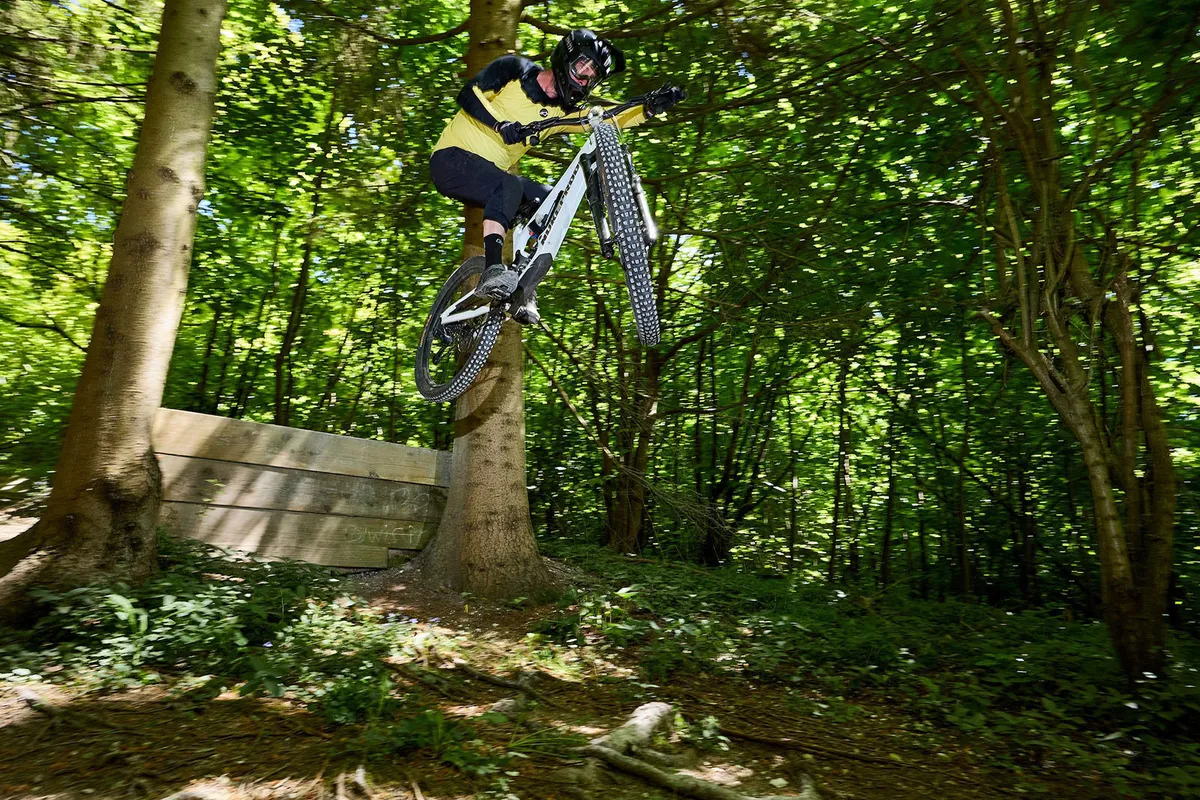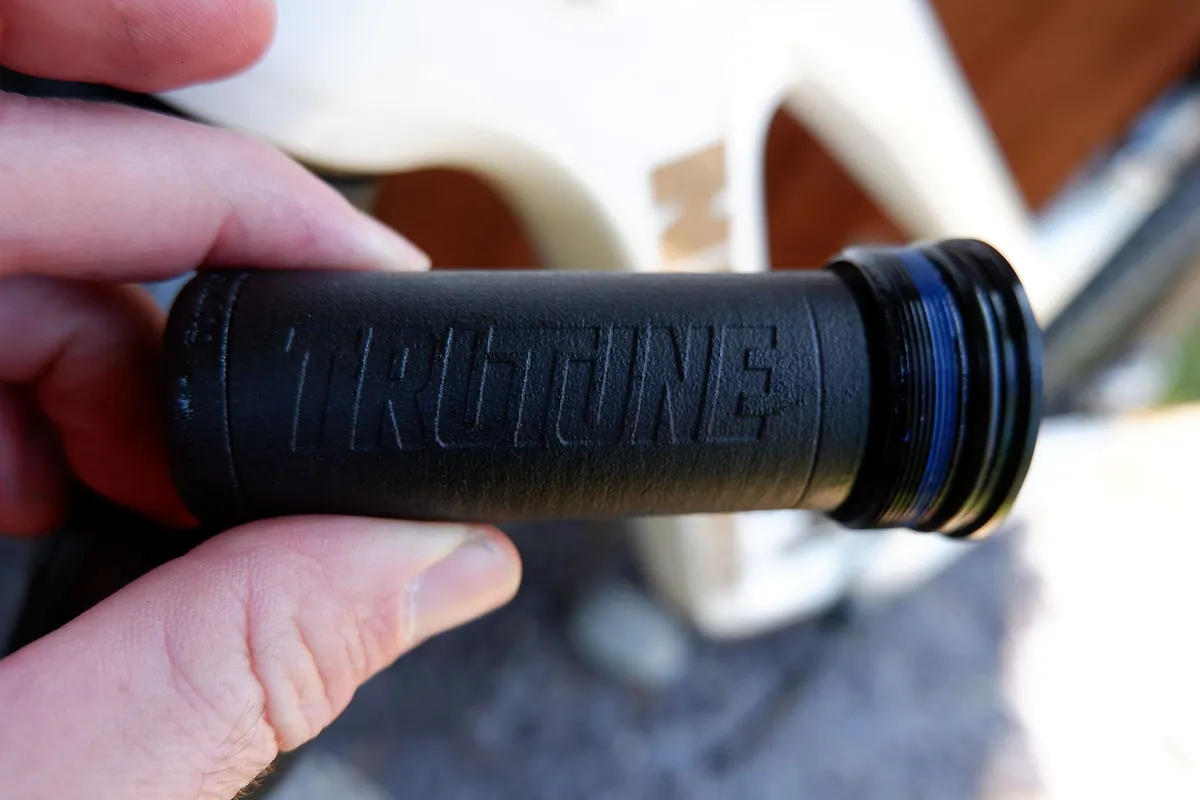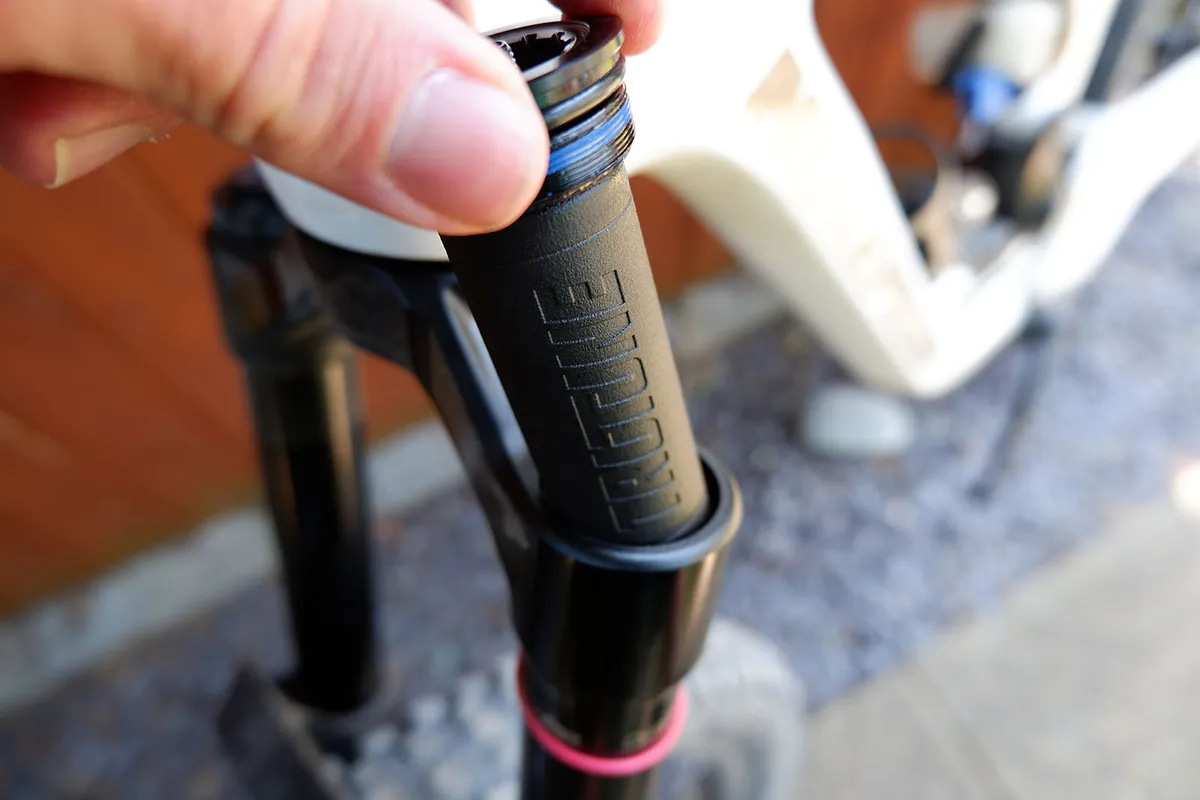TruTune’s air-sprung suspension fork insert is designed to improve plushness and sensitivity, creating a more linear, coil-spring-like feel and helping riders use more of their travel, more often.
Made from ‘activated carbon’ – which is carbon or charcoal that has been heated or treated to increase its absorptive properties – it effectively increases the air-spring volume in your forks by ‘absorbing’ some of the air within the pressurised spring.
Lighter riders, or ones who simply feel they’re not making the most of their fork’s travel, will probably benefit most from the TruTune insert.
It won't be for everyone, though, and if you cram volume-reducing spacers into your fork’s air spring to try to prevent it from bottoming out, you may want to consider alternative avenues to improve fork feel.
While the science behind how the TruTune insert works is complex, fitting it into your suspension fork couldn’t be easier. It will offer performance improvements, even if they may be subtle in some instances and in certain forks.
TruTune fork insert specifications and details

Inside the TruTune fork insert sits activated carbon – also referred to as activated charcoal – which is highly porous and has a massive surface area.
According to Carbon Air, the company behind TruTune, the air molecules within your fork stick to the surface of the activated carbon, packing in more closely than they would within an empty space.
“When air pressure is increased, extra air molecules are absorbed onto the carbon, which are then released when the pressure is dropped," TruTune explains.
"This results in a much more linear pressure curve, with a lower-pressure peak, despite the air chamber having exactly the same size."
The long and short of it is that by fixing this insert in place, the fork behaves as if it has a larger-volume positive air chamber.
So, in very simple terms, while adding a volume spacer reduces the size of the positive air chamber, making the spring harder to compress later in the fork’s travel (more progressive), the TruTune insert is designed to have the opposite effect.
It effectively increases the volume of the positive chamber and makes it easier to access that final part of the travel.
Compression sensitivity
There’s more to it than that, though.
TruTune states activated carbon also affects the dynamic behaviour of air, explaining that the stiffness of air varies with the speed at which it is compressed.
Importantly, compressing a gas (in this case, air) causes it to heat up. What happens to that heat is dependant upon the speed at which the gas is compressed.
According to TruTune, when compressing it slowly, the excess heat has time to dissipate, which lowers the pressure and hence the stiffness.
Situations where your suspension may be compressing slowly could include rider weight shifts as you pump your bike through undulations in the trail.
TruTune says if it’s compressed quickly, the excess heat doesn’t have time to escape the surrounding environment, resulting in a greater pressure increase, and so it has a higher stiffness.
Think along the lines of slamming into jagged rocks or chunky tree roots that can cause the fork to feel harsh, as if it's unable to compress and move the wheel out of the way fast enough.
TruTune says the exact opposite is the case because the gas expands as the fork extends, decreasing both the temperature and pressure.
According to the brand, by using activated carbon within the insert, it’s able to absorb the heat generated during a fast compression, releasing it as the fork extends, which ultimately creates a more consistent 'air stiffness' at varying compression speeds.
This means the amount of force needed to compress the fork when you do slam into those square-edge hits rapidly is reduced. In theory, this should help avoid harshness in those situations.
This can be particularly relevant to those who struggle to access the full travel from their fork.
With enduro bikes now sporting forks with 160 to 180mm of travel, eking out every millimetre just isn’t possible for some. This may be down to how progressive the air spring is, poor setup, rider weight or a combination of all three.
Insert options
TruTune offers two different size inserts: standard and short. The 'standard' RockShox/Fox version (to fit 35/36/38mm upper tubes), is the equivalent of removing three to six volume spacers from your fork, while the ‘short’ option is more like removing two to four spacers.
At present, TruTune offers inserts for only Fox and RockShox forks, with options for 32, 35 and 38mm upper tubes on RockShox forks. For Fox, there are inserts to fit 32, 34, 36, 38 and 40mm upper-tubed forks.
How I tested the TruTune fork insert

In a bid to really get underneath the claimed benefits of the TruTune insert, I first tested it in the 170mm RockShox ZEB Select fork before slapping it into a top-tier, 180mm-travel RockShox ZEB Ultimate, to see what the differences might be between fork models.
Both forks started with a single volume spacer fitted.
Testing involved a lot of back-to-back runs, switching from my original setup back to the TruTune insert and then back again. I also experimented with spring pressures when making these swaps.
The trails I used varied in gradient and speed, but all included hefty compressions, along with rough, rocky sections.
TruTune fork insert performance
TruTune fork insert setup

Fitting the TruTune insert is as simple as fitting a volume spacer. The standard-size insert I have here (to fit RockShox ZEB forks) simply screws into the underside of the air cap, just like a Bottomless Token (this is the name RockShox gives its volume spacers).
Once it’s screwed in place, you simply need to re-pressurise your fork. I found I needed to increase air pressure by a minimum of 10psi over the original (without the TruTune insert in place), though this did vary from fork to fork (more on that shortly). This was to balance support through the stroke and bottom-out resistance.
I asked TruTune's engineers about lubrication oil ingress, and they told me that while suspension oil does affect performance, it's not much of a concern with the TruTune inserts.
They explained: "The quantity in the fork is too small to have a noticeable effect even if it was completely soaked into the insert (it takes about five services' worth injected into the insert before it negates the volume increase).
"Oil migrates to the negative chamber, leaving even smaller quantities in the positive. This presents a challenge for our upcoming negative chamber inserts – for which we are likely going to suggest a specific grease and oil combination.
"Our filter is oleophobic and prevents it from entering in direct contact with the carbon.
"There is clearance round the side of the insert for excess oil to run to."
TruTune says its riders have used the inserts in forks for over a year without any change in performance.

Like a standard RockShox volume spacer, the TruTune insert screws onto the underside of the fork's aircap.On the more expensive ZEB Ultimate fork, with the TruTune insert fitted, the difference felt through the initial part and mid-stroke of the travel was relatively hard to pinpoint, especially on smaller, slower compressions.
It wasn’t until I started to use the latter part of the travel consistently when skipping through a matted root spread that I could really pick up on the effect it had on the ride.
In these instances, the fork felt smoother deeper into the travel and, as a result, more forgiving and comfortable, especially after I’d got a number of runs under my belt.
TruTune recommended upping the spring pressure once the insert was fitted and I agree. In order to maintain the same level of support and avoid any harsh bottom-outs, I found upping the spring pressure from 52psi to 63psi did the trick.
At this point, it’s worth pointing out that despite the increase in air pressure, the fork still sank into the initial part of its travel and felt incredibly supple.
Because the ZEB Ultimate uses the Charger 3 damper, there are also options to use the compression damping dials to further add support if it’s needed. However, I left mine alone, never needing to further increase the levels of support thanks to that offered by the spring.
I could feel the same difference through the latter part of the travel from the ZEB Select fork as the more expensive fork. Again, I was able to comfortably access the last bit of travel in a smooth, forgiving manner. However, overall differences were more pronounced through the rest of the fork travel.
When I got the fork to hunker down into its mid-stroke, things felt more comfortable, as if I’d removed a few psi from my front tyre. It’s a subtle difference, but one that doesn’t go unnoticed. The upshot is my hands felt that bit fresher on longer downhills and it felt as though my front tyre was better connected to the trail.
Again, I needed to up spring pressure in the ZEB Select fork, just as I did in the Ultimate, to ensure I could get the support I was after. I had to increase the spring pressure by 15psi to manage this, though.
After four months of use, I haven't noticed any drop-off in performance.
When pairing both forks with the coil shock I run at the rear, with the TruTune insert fitted, my bike felt better balanced pushing hard through rough terrain.
TruTune fork insert bottom line

There’s no denying £120 is a lot of money and, if you need your fork to really ramp up at the end of the stroke to prevent bottom-out, the TruTune insert maybe isn’t for you.
You could easily argue that spending the money on a full fork service and custom tune (which in some service centres costs less than the price of the insert) might be a wiser way to spend your cash and boost performance.
However, for a quick way to improve fork feel, providing its characteristics appeal to you, the TruTune is worth trying.
With both sets of forks I tried the insert in, I found more comfort later in the travel, as well as accessing more travel more easily. This might not be something everyone is after, though.
This trait, on the whole, made for a less fatiguing ride and helped create a nicely balanced feel when paired with the coil shock on my bike.
It was with the cheaper fork that I felt most benefit, and although those improvements were subtle, they still had an impact on ride feel.
Product
| Brand | trutune |
Features
| Features | Models available: RockShox 35 / 38mm RockShox 35 / 38mm short Fox 36 / 38mm Fox 36 / 38mm short Fox 34mm Fox 40mm RockShox 32mm Fox 32mm |
